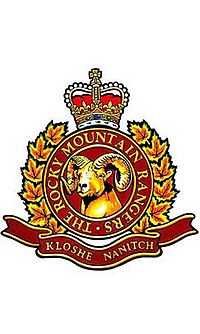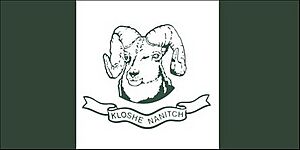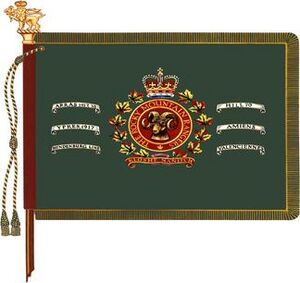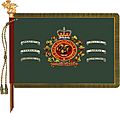Rocky Mountain Rangers facts for kids
Quick facts for kids Rocky Mountain Rangers |
|
|---|---|

The badge of the Rocky Mountain Rangers.
|
|
| Active | 1908-Present |
| Country | |
| Branch | Canadian Army |
| Type | Light Infantry |
| Role | To close with and destroy the enemy |
| Size | One battalion |
| Part of | 39 Canadian Brigade Group |
| Garrison/HQ | JR Vicars Armoury, 1221 McGill Road, Kamloops, British Columbia |
| Nickname(s) | "Rangers" |
| Motto(s) | Chinook jargon: Kloshe nanitch, lit. 'keep a good lookout' |
| March | "The Meeting of the Waters" |
| Commanders | |
| Commanding officer | Lt. Col Amedeo Vecchio, CD |
| Regimental Sergeant-Major | CWO Travis Trussler, MMM, CD |
| Insignia | |
| NATO Map Symbol (2017) |
 |
| Abbreviation | RM Rang |
The Rocky Mountain Rangers is a special group of soldiers in the Canadian Army. They are a Primary Reserve infantry regiment. This means they are part-time soldiers who train regularly. They can be called upon for duty when needed. Their main office is in Kamloops, British Columbia. The Rangers are part of the 39 Canadian Brigade Group. This group is a larger part of the 3rd Canadian Division.
Contents
How the Rocky Mountain Rangers Started
The Rocky Mountain Rangers have changed names a few times over the years.
- They began on April 1, 1908, in Nelson, British Columbia. They were called the 102nd Regiment.
- On June 1, 1909, they became the 102nd Regiment, Rocky Mountain Rangers.
- On March 12, 1920, their name changed to The Rocky Mountain Rangers.
- On January 1, 1941, they were called the 2nd (Reserve) Battalion, The Rocky Mountain Rangers.
- Finally, on January 28, 1946, they went back to being The Rocky Mountain Rangers.
It is important to know that this group is not connected to an older group. That older group was also called the Rocky Mountain Rangers. They were involved in the North-West Rebellion in 1885.
Honoring Past Units
The Rocky Mountain Rangers keep the memory alive of a unit from the First World War.
- This unit was the 172nd Battalion (Rocky Mountain Rangers), CEF.
What the Rangers Have Done
The Rocky Mountain Rangers have served Canada in many important ways.
The First World War
The 102nd Regiment, Rocky Mountain Rangers, was called to duty on August 6, 1914. Their job was to protect local areas.
Later, the 172nd Battalion (Rocky Mountain Rangers), CEF was formed on July 15, 1916. This battalion traveled to Great Britain on October 25, 1916. There, its soldiers joined another unit, the 24th Reserve Battalion. This was to provide more soldiers for the Canadian Corps fighting in Europe. The 172nd Battalion officially closed on July 17, 1917.
The Second World War
The regiment was called to duty on August 26, 1939. Some of its members began active service on September 1, 1939. They were called The Rocky Mountain Rangers, CASF (Details). Their job was to protect local areas. These soldiers finished their duty on December 31, 1940.
Then, the regiment created the 1st Battalion, The Rocky Mountain Rangers, CASF. This was for active service on January 1, 1941. This battalion served in Canada. They helped defend the country as part of the 18th Infantry Brigade. This brigade was part of the 6th Canadian Division. The Rangers also went to Kiska, Alaska. This was part of an expedition from August 16, 1943, to January 12, 1944. They were part of the 13th Canadian Infantry Brigade Group. On May 25, 1944, they sailed to Great Britain.
Their name changed on November 1, 1944, to the 1st Canadian Infantry Training Battalion. After VE-Day, on July 5, 1945, they became the No. 9 Canadian Repatriation Depot. This overseas battalion officially closed on January 28, 1946.
Afghanistan
Between 2002 and 2014, many Rangers helped in Afghanistan. More than 20% of their soldiers served in different groups there.
A Look at Their History
On July 1, 1898, five separate rifle companies were created. They were in Kamloops, Nelson, Kaslo, Rossland, and Revelstoke, British Columbia. These units were named after their locations. In 1900, they were renamed the Rocky Mountain Rangers. But they still worked as separate companies. No main headquarters was set up yet. That same year, nineteen men from these units went to fight in the Second Boer War.
On April 1, 1908, a new company formed in Nelson. This unit joined with three southern companies to create the 102nd Regiment. Its headquarters was in Nelson. An independent company also formed in Armstrong. The Rocky Mountain Rangers were then reduced to two companies. These were in Kamloops and Revelstoke. In 1909, these two companies joined the others. They formed the 102nd Regiment Rocky Mountain Rangers.
In 1912, the regiment changed again. Companies in Rossland, Nelson, Kaslo, and Revelstoke were closed. The headquarters moved to Kamloops. The Armstrong company also joined other units. Later that year, the Revelstoke company was brought back. More companies were added in Kelowna, Salmon Arm, Vernon, and Penticton.
When the First World War started, the 102nd Regiment Rocky Mountain Rangers helped protect local areas. In 1916, they formed the 172nd Battalion Canadian Expeditionary Force. This battalion went overseas. When they arrived, the soldiers were spread out to help other Canadian infantry units. The men did not fight as Rocky Mountain Rangers. However, the regiment earned special honors for their help in battles. These included Arras, Hill 70, Ypres 1917, Amiens, Hindenburg Line, and Valenciennes. In 1916, Princess Patricia of Connaught gave the 172nd battalion special flags. These flags later showed the battle honors.
The 102nd Regiment continued to serve in Canada during the war. One of their jobs was to staff internment camps. These were in Revelstoke, Mara Lake, and Vernon. The 102nd also sent many soldiers to the 54th (Kootenay) Battalion. In 1917, the 172nd Battalion was closed. Its history was carried on by The Rocky Mountain Rangers. In 1920, the regiment was renamed The Rocky Mountain Rangers. It was reorganized into four companies. This structure stayed mostly the same until the Second World War.
In August 1939, the regiment was called to duty for local defense. They guarded important points along the CPR/CNR railways. By early 1940, the Royal Canadian Mounted Police took over this job. This was because many Rangers had left to join other active units.
In June 1940, the regiment was ordered to become a full wartime unit. It was renamed The Rocky Mountain Rangers CASF. The 1st Battalion was put on duty for west-coast defense. They served in Vancouver, Prince Rupert, and Vancouver Island. In one famous event, the battalion marched from Kamloops to Vancouver. This 500 km march took 14 days. Temperatures reached 40 degrees Celsius. The unit's current members re-enacted this march in 1998.
The situation in the Pacific Ocean became a real threat. To meet this danger, the reserve unit was renamed the 2nd Battalion. It was assigned to the 39 (Reserve) Brigade Group. Their job was to protect important industrial spots along the CPR rail lines. They also recruited and trained soldiers to defend the west coast. Their headquarters stayed in Kamloops. But the battalion was spread out along the main rail lines.
In 1943, the 1st Battalion sailed from Vancouver Island. They went to an American base on Adak Island in Alaska. There, they trained for an attack on Kiska. Kiska was an island held by the Japanese. The Rocky Mountain Rangers were the main part of the 16th Canadian Combat Team for this attack. The force sailed from Adak on August 13. The attack was planned for two days later. However, the Japanese had already left the island. They left under the cover of fog and darkness. The Rangers stayed on the island until mid-January 1944. Sadly, they lost an officer and several men to traps and accidental friendly fire. This operation is remembered every year. The unit's Christmas dinner is called the Kiska dinner.
Later that year, the 1st Battalion sailed to Europe. They were part of the 13th Infantry Brigade. In England, the Rangers were welcomed by a British regiment. This was The Green Howards. This started a close friendship that continues today. The two regiments became official allies in 1948. Just like in the First World War, the 1st Battalion was split up. Its soldiers joined other Canadian units that needed more people. Over 5000 Rocky Mountain Rangers fought overseas with other Canadian units.
In 1946, the unit returned to being a reserve unit. Its headquarters was in Kamloops. There were companies in Kamloops, Prince George, Salmon Arm, Armstrong, and Revelstoke. In 1952, the Revelstoke company moved to Whitehorse. This company became inactive three years later. In 1959, the Armstrong company headquarters moved to Revelstoke. This setup lasted until 1970. Then, the companies in Prince George and Salmon Arm were closed. In 1978, the Revelstoke company moved to Salmon Arm. In 1998, the Salmon Arm company was closed. It was then moved on paper to Kamloops.
The original Regimental Colour was given to the regiment by Princess Patricia in 1916. It now hangs in St Paul's Cathedral in Kamloops. In 1983, Prince Philip, Duke of Edinburgh, gave the regiment its first official colors. This was in a ceremony in Kamloops. A new Regimental Colour was given in 1998. This was after the regiment officially went back to using green colors. Green is used by rifle regiments. Blue was used by line infantry regiments.
The Freedom of the City was given to the regiment by Kamloops in 1982. Salmon Arm gave it in 1992. Prince George gave it in 2018.
Recent Activities
In 2008, 12 soldiers from the unit went to Afghanistan. Since then, more troops have been sent to support Canada's efforts there. 2008 also marked the unit's 100th anniversary. This made it one of the first reserve units in British Columbia to reach this milestone. Besides Afghanistan, the Rocky Mountain Rangers also helped at the 2010 Winter Olympics.
In February 2011, the 39 Canadian Brigade Group announced something new. The Rocky Mountain Rangers would open a company-sized group in Prince George. This was forty years after the unit there had closed. The Rocky Mountain Rangers are still recruiting successfully in Prince George. "B" Company is now almost company size. In 2016, about 60 soldiers were training in Prince George. This was more than the 30 expected in 2013.
Battle Honors
Battle honors are special awards given for bravery in battles. Honors in capital letters are for large operations. Honors in lowercase are for specific battles. Those with a "+" are shown on the regimental color.
First World War
- Arras, 1917, '18+
- HILL 70+
- Ypres, 1917+
- Amiens+
- Hindenburg Line+
- Valenciennes+
War in Afghanistan
- Afghanistan
Cadet Corps
There are several Royal Canadian Army Cadets groups. These groups are for young people. They are connected to the Rocky Mountain Rangers in British Columbia.
| Corps | Location | Started | Status |
|---|---|---|---|
| 950 RCACC | Merritt | December 13, 1921 | Active |
| 1787 RCACC | Salmon Arm | February 28, 1941 | Active |
| 2276 RCACC | Fort St. John | September 3, 1946 | No longer connected |
| 2305 RCACC | Kamloops | January 26, 1948 | Active |
| 2458 RCACC | Revelstoke | October 1, 1952 | Active |
| 2510 RCACC | Sicamous | January 1, 1954 | Closed 2015 |
| 2618 RCACC | Prince George | January 13, 1958 | Active |
| 2887 RCACC | 100 Mile House | September 1, 1971 | Active |
| 2941 RCACC | Clearwater | October 15, 2002 | Status unknown |
| 3063 RCACC | Enderby | March 31, 2000 | No longer connected |
| 3064 RCACC | Williams Lake | September 1, 2000 | Active |
Alliances
The Rocky Mountain Rangers have a special friendship with a British regiment.
 United Kingdom - The Yorkshire Regiment (14th/15th, 19th and 33rd/76th Foot)
United Kingdom - The Yorkshire Regiment (14th/15th, 19th and 33rd/76th Foot)
The Rocky Mountain Rangers Museum and Archives
| Location | JR Vicars Armoury, 1221 McGill Road, Kamloops, British Columbia Canada |
|---|---|
| Type | Regimental Museum |
This museum collects and keeps old items, papers, and records. These items tell the story of The Rocky Mountain Rangers. They show the regiment's history during times of peace and war. They also show its place in Canada's military history. The museum is for both soldiers and the public to learn from.
Media
- The Cowboy Cavalry: The Story of the Rocky Mountain Rangers by Gordon E. Tolton Heritage House (Aug. 24 2011)
- Recollections of a Rocky Mountain ranger by Jack C. Moomaw, YMCA of the Rockies
Images for kids





